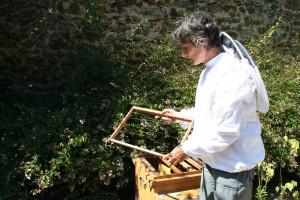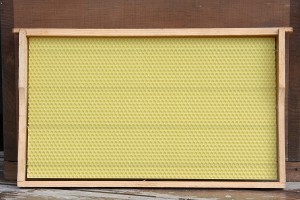Following her introductory remarks, Annie-Claude Bonnet took us over to an unoccupied bee hive that the association uses to demonstrate the art of beekeeping. The hive consists of one or more wooden boxes stacked on top of one another. Within each box are frames that hold the wax foundations upon which the bees build hexagonal wax cells. These cells eventually contain larvae and stores of honey and pollen.
In the photo above, Madame Bonnet is showing an empty frame that has wires strung across it. These wires support a sheet of beeswax that the beekeeper places there. The sheet has an imprinted hexagonal pattern that provides a foundation upon which honeycomb cells are built.
When it is time to harvest the honey, the beekeeper withdraws the honey-laden frame from the hive, removes the wax covering that the bees have created to protect the honey-filled cells, and places the frame in a centrifuge. The centrifuge extracts the honey without damaging the comb. It can be reinserted into the hive.
The combs in which the bees store their honey are not the same combs in which they raise their larvae. Only the combs containing honey are removed. The beekeeper leaves the combs that contain larvae intact, thus preserving the life of the colony.
Tuesday…we visit an active bee hive.
Like our blog? Join us on Facebook!
Tags: beekeeping, honey, Rucher Audonien Pédagogique, Saint-Ouen



